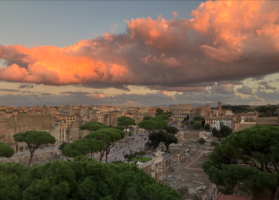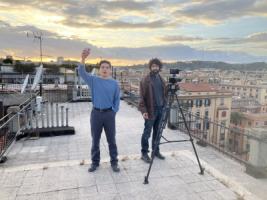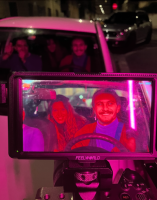
By Henry Worsley
I love Federico Fellini’s film roma. Perhaps critics could accuse the director of being pretentious or indulgent in other films he made, but here he is undeniably down to earth. What he creates is the ultimate portrait of the Eternal City – a description of a huge and irreconcilable oxymoron: both ancient and modern, proud of its history yet embarrassed of its dirt, its poverty, its bad traffic. Rome is sacred and profane, beautiful and grotesque, generous and ruthless. Fellini’s Rome, the Rome of 1972, is veiled constantly in a noxious haze, rising from the exhausts of a million FIAT Pandas zooming all over the place. But this haze is golden, it gives the sunlight a milky, dreamlike thickness; it turns the city into an open-air backlot, a vast film set. Fellini’s roma is presented in the lower case; it rejects the grandiose, all-caps inscription some wandering pilgrim might have seen whilst walking along the Via Francigena a thousand-or-so years ago: ‘ROMA, 500 miles’. Fellini knows that Rome is more than the Forum, the Colosseum, Saint Peter’s, the Spanish Steps, the Trevi Fountain. He offers up the city’s ring road, the GRA, as an equally important landmark to all of these picturesque spots, and he is right – it is part of the real Rome that Romans live and breathe every day.
For the past year, I have been living in Rome for my degree. I came for the language, but I also came for the cinema. Vittorio De Sica, Pier Paolo Pasolini, Sergio Leone, Luchino Visconti, Michelangelo Antonioni, Nanni Moretti, Paolo Sorrentino – just a few of the big names that have come to this city as pilgrims, not to visit the man in Saint Peter’s with the little white cap, but to make it, to make movies. Rome, in many ways, could be described as the Los Angeles of Europe (hear me out!) – yes, it has much better food, art, architecture, etc., but it also has terrible public transport, pollution, a long sandy coastline nearby, and – most importantly – a population of three million people that have almost all, at some stage, been involved in the movie business. Cinecittà, the vast studios close to the Via Appia, has often rivalled Hollywood in the number and success of its productions. Many non-Italians forget that this is the city of cinema, not just for Italy, but for all of mainland Europe, and it is where some of the greatest films of the last hundred years have been made.
I have had the opportunity to write and direct two of my own short films here, and help out on almost ten others for my fellow students. And really, Rome is the best backdrop you could hope for as a filmmaker. Why? Maybe it’s the way people get things done here (or don’t get things done; the idea of the dolce far niente – the ‘sweetness of doing nothing’ – is a distinctly Roman institution).

Living here, you quickly get a taste for that special chaos alla romana: the first thing I see when I arrive at my new apartment in Portuense is fire – one of the bins has gone up in flames. Nonnas run outside in their pyjamas, carrying big saucepans full of water. ‘Italo, vieni! Il cestino ha preso fuoco!’. A man holds the gate open for me, a cigarette hanging out the corner of his mouth. He looks tired, nonchalant, like an older Marcello Mastroianni. ‘Ciao, caro,’ he says, ‘benvenuto.’
Most Romans are like this – they’re natural born stars of the silver-screen, they are the kings of cool.
Do the locals keep their cool in traffic, though? Certainly not. Madonna in cielo! Roman traffic is as much a core part of the city as Piazza Navona or bucatini all’amatriciana. Roman traffic is pure cinema, nothing sums up the chaos of this place like the way that people drive. Closer to the Vatican, I once spotted a Benedictine monk on his way to work, trundling down the Lungotevere on an e-scooter in the wrong direction – you can tell how incensed the passing drivers are by how high they raise their hands out the window; some of them yelled at the monk, some yelled at each other as they swerved to avoid him – others, invariably chain-smoking at the wheel, did not even raise a finger, they just moved on by, blasting Lucio Battisti on the radio. The sacred, the profane, the downright silly, it’s this sort of absurdity which makes the place, and as soon as you try to take the city too seriously, you lose sight of what the whole mad boiling pot of humanity is about. It may no longer be caput mundi in the same way that you could call London or New York centres of the world, but Rome hasn’t lost that spirit, that wonderful, frenetic buzz of a thriving Mediterranean capital.

It is difficult, almost impossible, to paint an adequate portrait of Rome in a few hundred words. Here I have written about traffic and cinema – I haven’t touched on the two thousand seven hundred and seventy-seven years of history piled up on each of the seven hills; I haven’t written about Aeneas, Caesar, Charlemagne, Caravaggio, Garibaldi, Mussolini, Aldo Moro, all the bloodshed and destruction that has brought us to this point in time – but this is ROMA in capital letters, not roma, and it is this second Rome, in the lower-case, which is far too often overlooked.